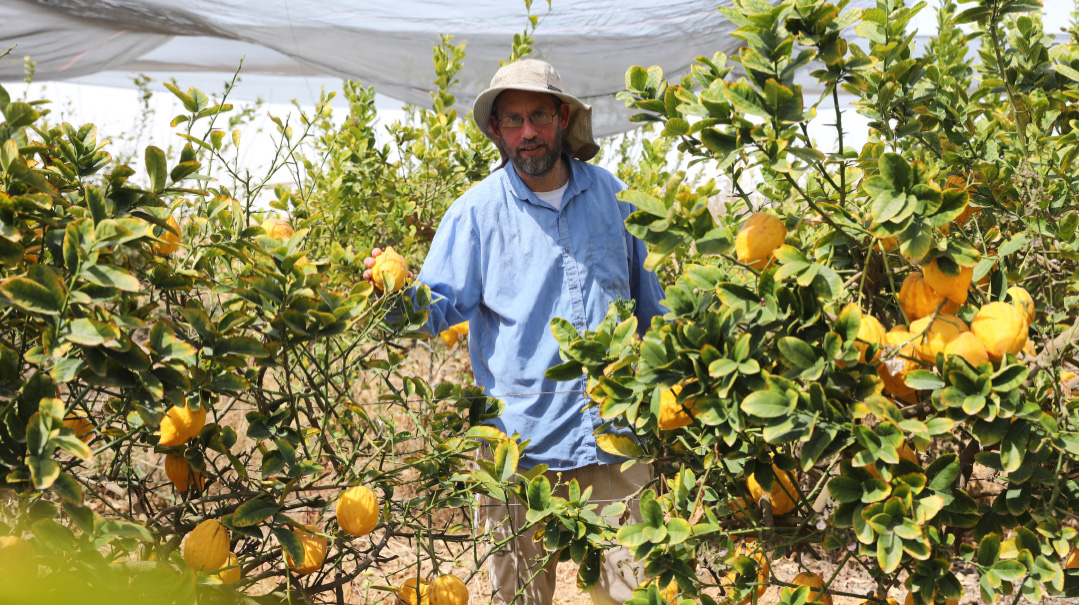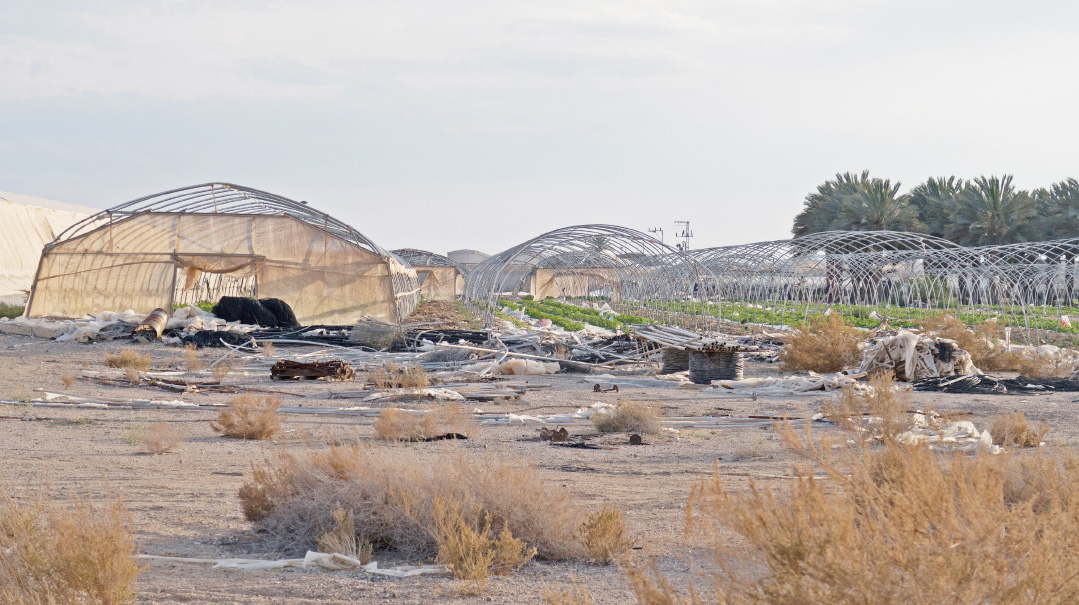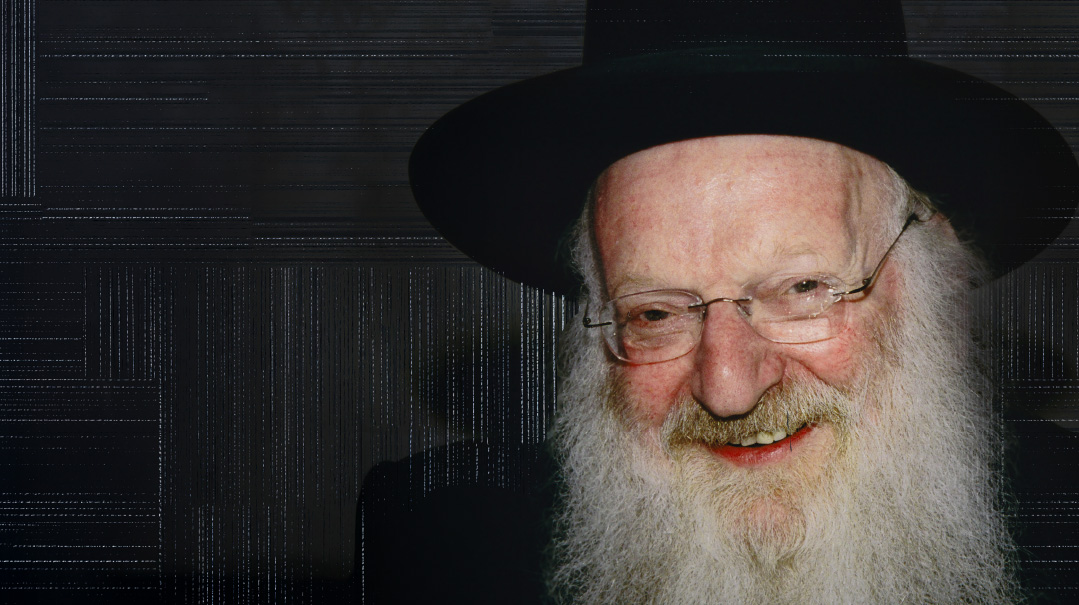Bitter Fruits


“Agriculture wasn’t just collateral damage, as the general narrative goes. It was a deliberate target”

Photos: Menachem Kalish, Keren Hashviis, Pivot Group
The destruction of agriculture in the western Negev and beyond wasn’t merely collateral damage from Hamas’s murderous rampage through the Gaza Envelope. That rampage was a targeted assault to cause economic ruin to a country that not only relies on its own agriculture, but that’s also been at the forefront of innovative techniques to help feed the world. For farmers around Israel facing collapse, assistance has come from a surprising source
There is an untold backtory to the gruesome Hamas massacre last Simchas Torah, tied into an agenda that went beyond their savage rampage of kidnapping, torture, violation and murder. Hamas was out to destroy the entire agricultural infrastructure of the western Negev and hoped that would cause an economic collapse. It was agricultural terrorism at its best, or worst.
We all know by now just how fiendish the Hamas attackers were, based on their very own documentation of the rampage. They wanted Israelis, and Jews the world over, to witness their savagery in all its grisly detail — to contemplate the psychological cruelty of children forced to watch their parents murdered before their eyes and vice versa, of women treated without a flicker of humanity. It was a systematic attempt to terrify the objects of their hatred so that the latter would give up and run away, abandoning their land.
But that wasn’t all. Their actions were carefully planned in order to inflict the greatest possible damage, physically, emotionally, and economically. The terrorists had complete plans of each agricultural kibbutz or moshav that they invaded, and therefore knew how to shut down the systems at their source. Those infrastructure plans were meticulously gathered by the thousands of Gaza residents who passed through the various border crossings every day to work on the Jewish settlements — treated as friends by their employers who would have coffee with them, help their families with medical care, and buy presents for their children.
“Agriculture wasn’t just collateral damage, as the general narrative goes. It was a deliberate target,” according to Moran Freibach, the head of agriculture in Nahal Oz, one of the 32 agricultural communities of the Eshkol Region that produce 70 percent of Israel’s vegetables, 20 percent of its fruit, and six percent of its milk.
Freibach described to a generally complacent media how it wasn’t simply wanton destruction: The terrorists systematically targeted farmlands, livestock, irrigation systems, and other infrastructure, as they moved through the western Negev. While some media outlets, including the Jerusalem Post, Times of Israel, and Wall Street Journal picked up the story, it’s been largely ignored and generally unknown in the public sphere.
In Freibach’s community of Nachal Oz, all 40 irrigation control boxes were smashed and the terrorists went straight for the customized computer chips that regulate the entire system; every farm vehicle was either burned or taken into Gaza.
All over the Gaza Envelope region, greenhouses and barns were trashed and many rendered irreparable, crop lines were cut, fields were deliberately flooded, irrigation pipes were burned, and expensive and sophisticated fertigation systems, which disperse dissolved fertilizer through irrigations systems, were destroyed. The dairy and egg industry took a hit as well: Milking lines were cut, 600 dairy cows were blown up and for the surviving cows, feed became inaccessible. Simultaneously, Hezbollah in the north, with the same determination to destroy agriculture, repeatedly targeted farms in the upper Galil, at one point killing 9,000 chickens in Moshav Avivim.
The damage caused by Hamas terrorists was compounded when Israeli tanks entered the area to combat the terrorists. Soil compaction and pollution caused by the heavy tanks rendered about ten percent of the formerly fertile farm soil incapable of sustaining crops.
Because Israeli agriculture can’t survive without foreign workers, the terrorists located, massacred, and abducted foreign workers in order to neutralize this vital labor source. Captured terrorists even showed their Israeli interrogators the maps they had of the barracks where Thai agricultural workers slept. When the first Israeli soldiers reached those barracks, they found Thai workers not just killed, but horribly mutilated. Those photos were subsequently sent to the king of Thailand, with the specific intent that he would order his subjects to return to Thailand. Indeed, 85 percent of the Thai agricultural workers fled (some of them have since returned to Israel’s south, but they still haven’t returned to the north because of the constant shelling).
“This narrative has been remarkably absent from our collective conversations about October 7th,” points out Danielle Abraham, founder and director of Volcani International Partnerships, an offshoot of the Volcani Institute for agricultural research. VIP was set up to aid foreign countries in increasing their agricultural output using innovative Israeli agricultural products, and has, in the wake of the agricultural destruction resulting from the war, launched ReGrow Israel, dedicated to strengthening the devastated agriculture industry of the western Negev.
She explains that farming was targeted because it embodies the Jewish People’s attachment to the land of Israel, but not only. Farming drives the economy of the western Negev, and the attack threatened the underpinnings of Israel’s food security and has put the country’s self-sufficiency into jeopardy.
Israel’s fruit and vegetable production is now at such a diminished output level that prices for local produce have soared, while much of the produce you see on the shelves is imported from Turkey and other countries.
While the world somehow has come to expect a level of Israeli resilience, she says there can be no talk of resilience “if the farmers can’t even restart where they were without entering loads of debt.”

Even farms that weren’t attacked are in dire straits, with crops rotting on the trees and fields. Between farmers who’ve spent the last half year in the military reserves and the neutralized labor source of foreign workers, Israel’s fruit and vegetable production is at its most diminished output level
Bottom of the List
The farmers hardest hit on October 7 were obviously those in the agricultural settlements bordering Gaza, whose farms were in the path of destruction. But they were far from the only farmers devastated by the impact of the massacre, as their future hangs in the balance.
Pinchas Appelton, an avocado farmer on Moshav Margaliot near the Lebanon border (where a foreign worker was killed by a Hezbollah missile last month), says he’s lost the majority of his crop, most of which rotted on the trees. Ditto for Oded Korokin and Yair Ziv, two farmers from the center of the country who both lost most of their red pepper harvest (which might explain why, for months, Israeli consumers haven’t been able to find quality red peppers in their produce section).
Yehuda Alon is another hard-hit farmer from the center of the country who leases land from Moshav Nechusha. While he lives 30 miles away from Gaza, on Simchas Torah morning, Yehuda was at the six a.m. minyan when the people in the minyan began to hear massive rocket fire from Gaza — hundreds of missiles were being launched nonstop. At first, they guessed that perhaps the IDF had killed a senior Hamas commander, but when the rocket fire continued, they realized something more was taking place. Worshippers returned home to check their cell phones, and soon learned that Hamas had penetrated the border en masse, posting videos of their slaughter of Jews as they went along.
Yehuda checked his battalion WhatsApp group and received an order from his brigade commander to report to the base in Rechovot. When Yehuda — who leads his own unit of 19 men — asked why that order was coming via WhatsApp and not from the IDF directly, his commander replied ominously, “The army won’t call. There is no army,” referring to how unprepared the army was to stop the invasion. (Yehuda’s wife and a 14-year-old daughter used all their powers of persuasion to prevent him from leaving — until they realized there was nothing more to say. “We’re fighting for our lives, as we’ve been doing for thousands of years,” he told his family. “Now it’s my turn.”)
When members of the group arrived in Rechovot, the young sentinel knew nothing of their ordered arrival and refused to let them in. Yehuda and his comrades scaled the fence, and three hours later were on their way to Kfar Aza, where the sights, Yehuda says, were indescribable — they spent three days there and killed over 250 terrorists who had taken over the small kibbutz. Subsequently, they were transferred to the northern border to thwart an anticipated Hezbollah invasion.
After a month and a half in the country’s north, Yehuda’s unit was transferred to Khan Younis in the southern part of Gaza. There Yehuda was wounded when an IED exploded in a booby-trapped building that he and his men had just entered. An IDF medic told Yehuda that he would have to be evacuated to a hospital, but he refused to leave the men under his command.
“I’m okay. I’m standing on my feet. There’s no reason to go,” he insisted, but to no avail. Once in the hospital, Yehuda urged the doctors to release him, but tests revealed bleeding from his kidneys and other internal hemorrhaging, and he was hospitalized for six days before returning to the battlefront.
In all, Yehuda was away from his family for four-and-a-half months — smack in the middle of the harvest season for the 40 acres of wine and table grapes that he grows annually. The season lasts from early August until the end of November, and this year Yehuda lost a hundred tons of grapes valued at 700,000 shekels, which he was unable to harvest.
“Cutting the grape vines requires expertise, and it’s not the kind of work that can be done by volunteers, no matter how well-intentioned they might be,” Yehuda says.
In addition to the grapes, the Alons grow lettuce plants and fennel. Mrs. Alon, who grew up in Gush Katif in the Gaza Strip, attempted to harvest the lettuce together with volunteers, but she was only able to save about ten percent of the 600,000 plants they were growing.
Prior to October 7, Yehuda relied on Arab workers from Judea and Samaria. They are currently barred from entering Israel, and, in any event, Yehuda says, “I would never take back those guys.” So meanwhile, he’s left waiting for the government to conclude negotiations for foreign workers with countries such as Ghana, Sri Lanka, and India — but those negotiations can take months even under the best of circumstances.
In order for an Israeli farmer to be destroyed financially by the war, his farm need not have been targeted. It is sufficient that he was absent and that his workers disappeared.
“On one hand, I know that I’m fortunate,” Yehuda says. “Neither my wife nor my four daughters were in direct danger on October 7, and Hamas terrorists didn’t destroy my equipment.” Yet he’s on the verge of financial ruin.
In February, he received notice from the national water company that his water was about to be cut off for nonpayment of accumulated debts. Like many Israeli farmers, Yehuda was still reeling from the loss of income due to Covid restrictions. During Covid the ports were closed globally for lengthy periods of time, making it impossible to export the farm produce to other countries. And within Israel, tourism plummeted, hotels were shuttered, and many stores were closed — meaning farmers had far fewer buyers. Tens of thousands of tons of produce were left rotting in the field — it didn’t even pay to harvest. And in the case of shomer shemittah farmers like Yehuda, the last shemittah was another year without income from his land.
Apart from efforts to bring in foreign workers, however, the Israeli government is nearly as absent as the IDF was on the morning of October 7. It has yet to institute a moratorium on payments from farmers to the water company. Nor is it providing farmers with the wherewithal to get back on their feet or to meet the payments on their expensive machinery.
“Farmers are at the bottom of the list,” says Yehuda. “The government is busy with tens of thousands of displaced families, with rebuilding the basic infrastructure of the destroyed towns, and with the immediate costs of the war, which take precedence.”
Meanwhile, insurers are denying farmers payment for lost machinery and greenhouses on the grounds that acts of war are specifically excluded by their policies.

An abandoned kibbutz farm in the western Negev. This wasn’t collateral damage, but a targeted attack in order to cripple the economy and bring the agricultural sector to its knees
Who Will Step In?
For Yehuda, relief came from a quite unexpected place. He learned that while he was in Gaza, Shia Markowitz, CEO of Keren Hashviis, made sure that two separate deposits went into his account, totaling more than 200,000 shekels. The organization also subsequently negotiated a settlement with the water company.
“I was shocked,” Yehuda says. “I hadn’t been in touch with the fellows from Keren Hashviis since the shemittah year two years ago when they helped me out. Yet when I got back from Gaza, there they were. ‘We want to help you,’ they said. ‘For the farmers, the war has just begun.’ ”
“When the war began, my immediate focus was on our farmers,” Reb Shia explains. “The Hamas massacre targeted the farming community in the south, and I felt compelled to monitor the situation. I asked our team in Eretz Yisrael to visit the farms and find out how the farmers were coping with the war. By December it became clear that farmers were not able to harvest their produce, and even the farms that weren’t in the war zone had lost their workers, making it impossible for them to save most of their produce. And the government, focused on the war, wasn’t stepping up to help the farmers.”
Reb Shia is a veteran communal activist who began his klal career in the early 1980s raising millions of dollars to smuggle kids out of Iran who would otherwise have been used as human minesweepers in the killing fields of the raging Iran-Iraq War. He was part of the core board of Dor Yeshorim, was behind an effort to create a national registry for patients in need of bone marrow transplants, and was part of a secret committee that helped spirit over a million Soviet Jews to Eretz Yisrael during the power vacuum following the fall of the Iron Curtain. In 2015 he was appointed CEO of Keren Hashviis, and following that shemittah year he became CEO of Agudath Israel of America. At the urging of Rav Chaim Kanievsky ztz”l, he stepped down before 2020 in order to take the reins of Keren Hashviis again, where he remains today. Since then, he’s been at the forefront of the farming scene in Eretz Yisrael, interfacing with farmers and sharing their challenges. But nothing could have prepared him for today’s calamity.
Yehuda, for his part, is lucky that — debts notwithstanding — he still has a farm to go back to. Some of his colleagues have yet to return to their land. Amos Moshe, a farmer from Nir Oz, is one of those.
During the massacre, Amos’s father, a lifelong farmer who grew potatoes and carrots, was murdered, and his mother, Adina, was kidnapped (she was released in the November hostage exchange). Amos describes how his father, who fervently believed in coexistence with his Gazan neighbors, would often fete his Gazan employees with sumptuous meals. Those same neighbors poured in following the first batch of Hamas attackers, killing and looting. Amos survived by holding on to the door of his safe room for hours while his wife and five children were inside, even after the terrorists set the house on fire (his hand was badly burned). Amos has yet to return to the kibbutz, though. The houses are still not habitable.
So far, Keren Hashviis is the only private organization giving over 150 farmers real-time bail-out funds to tide them over through this crisis
Yet despite their multi-million-dollar shemittah initiative, which raised close to $54 million globally in the last shemittah year and was able to sustain nearly 4,000 farmers and keep 686,000 dunams of privately-owned Jewish farmland fallow, their new “Save a Farmer” campaign might have raised some eyebrows: What does making sure the Holy Land lies fallow in the seventh year have to do with keeping farmers solvent during the war? After all, Keren Hashviis was not created to provide business insurance, even for shomer shviis farmers.
Indeed, the decision of Keren Hashviis to make this shift was based on a critical national interest, as well as concern for the fate of individual farmers. It’s not just about helping individual farmers navigate a collapsed business — it’s actually about Israel’s food security. Because one of the state’s best-kept secrets is that if the Jewish farmers go under, Israeli Arabs will be more than happy to swoop in and take over. It turns out that more and more land in Israel is being leased by Arabs, who are willing to pay top dollar to buy off leases from Jewish farmers who are either too tired to continue or are no longer making a profit.
Reb Shia heard that farmers were starting to talk about giving up their fields — this was their third financial hit in four years.
“Engaging and helping the farmers in their time of need would surely help save more farmland that had the potential to lie fallow during shemittah,” Reb Shia says. “Besides the immediate mitzvah of being nosei b’ol im chaveiro, we’ve developed stronger bonds to many farmers who will not only continue to keep shemittah but will also act as our ambassadors to gather additional farmers to become shomrei shviis.
“No one can say when this war will be over,” he continues. “There are still over 80,000 people displaced from their homes and from farms — mostly in the north — who have no idea when their nightmare will end. Who else is looking out for them, making sure that they have the ability to survive this emotional and financial trauma? But there was something else we realized as well — if farmers give up their farms, there’s a real danger of these farms being leased by Arabs.”
Land for Lease
What non-farmers don’t realize is that most farmers don’t own the land they farm on. They lease it from other farmers who, for one reason or another, no longer want to be active farmers. The Arabs are very aware of this and in order to get a stronger foothold in Eretz Yisrael, they have an agenda to outbid Israeli farmers for the lease.
“This isn’t something new. Every decade the number of dunams lost to the Arab sector grows, and that is an enormous secret concern to Eretz Yisrael,” says Reb Shia. “In the past 20 years alone, we’ve lost control of an additional 400,000 dunams of Israeli farmland to non-Jewish occupants. Much of the farmland is close to the northern and southern borders, which means we’re relinquishing this strategic border buffer zone to our enemies.”
To test this, Ofir, a farmer in the Lachish region, opened a Facebook page advertising that he was looking to sublease a certain parcel of land that he no longer wanted to work. Within the hour, he had 12 responses – all of them Arabs.
“They come to the Jewish farmers with suitcases of cash,” Ofir says. “I met a sheikh who offered me a wad of bills to buy out my lease.”
Nahva Follman is COO of Neshei Keren Hashviis, which works with families throughout the seven-year cycle to keep up the inspiration. “When a wife is willing to say to her husband, ‘Okay, so we’ll sacrifice, we’ll get by with what we have, with what Hashem sends us,’ this empowers the farmers more than anything,” she says. She hopes that infusion of faith will encourage the farmers not only for the next shemittah, but also during the hard times they’re facing now.
Deciphering the breakdown and rules of land ownership in Israel is a confusing chapter in and of itself. As a general overview, approximately 1,800,000 dunams of land are under the auspices of the Jewish National Fund (Keren Kayemet LeYisrael), 925,000 dunams belong to kibbutzim, 1,340,000 dunams belong to moshavim, 660,000 dunams are under the jurisdiction of Arabs, and a very small amount is evenly divided between private Arab and Jewish owners. Even many Israeli homeowners don’t realize that the land they’re living on doesn’t belong to them.
So, if the land ownership will still be retained by the government, or the moshav, and it’s just a lease, does it really make a difference who is farming it?
“There’s a lot of farmland out there with no one to farm it,” Nahva, who is also a licensed real estate professional, explains. “Today fewer and fewer people want it — you know, you have to be born into it, you have to really love the land, and so forth. So many are leasing out their land to whoever is willing to pay. And right now, in the wake of the war, close to 200 of our farmers are in real danger of losing their land. Imagine all that land up for grabs.
“True, the Arab who buys out the lease doesn’t own the land, but he’s leasing it, and that means he’s controlling it. He can bring his family onto it to live. If it’s close to the border, we can basically say goodbye to it — it might no longer be safe to pass through. Because as we know from all over the world today, with all kinds of squatters’ rights, it’s not about who owns it, but who’s sitting on it.
“And remember,” she continues, “this was the enemy objective — to destroy our farms, chase away our workers, cripple our economy, bring our agricultural sector to its knees, and ultimately leave hundreds of farms abandoned for the taking. It’s happening — and nobody’s watching.”
(Originally featured in Mishpacha, Issue 1015)
Oops! We could not locate your form.







